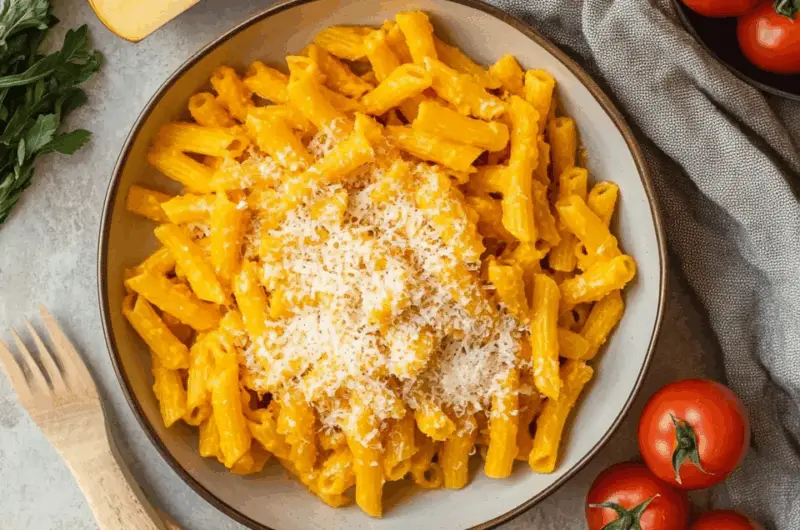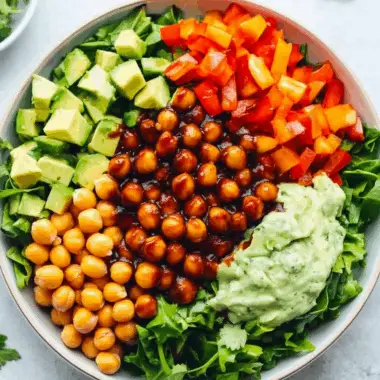Make a creamy vegan Butternut Squash Pasta Sauce with just a few simple ingredients. This easy recipe uses frozen butternut squash for convenience and combines it with roasted tomatoes, onions, and seasonings to create a flavorful fall comfort food. The roasted veggies are blended with reserved pasta water to make a smooth, creamy sauce perfect for tossing with your favorite pasta.
Full Recipe:
Ingredients
-
16 oz bag of frozen diced butternut squash
-
1.5 cups fresh chopped tomatoes
-
1/2 yellow onion
-
2 tbsp olive oil
-
1 tsp salt
-
1/4 tsp black pepper
-
1/2 tsp dried thyme
-
1 lb pasta
-
1/3 cup pasta water reserved from cooked pasta
Directions
-
Preheat oven to 450°F and line a baking sheet with parchment paper.
-
Place frozen cubed butternut squash, chopped tomatoes, and sliced onion on the baking sheet.
-
Drizzle olive oil over the vegetables and season with salt, pepper, and thyme. Mix to evenly coat.
-
Bake for 20 minutes at 450°F.
-
While veggies bake, cook pasta according to package instructions. Before draining, reserve 1/3 cup pasta water and set aside.
-
Blend the hot roasted veggies with the reserved pasta water until smooth.
-
Pour the sauce over the cooked pasta and toss to coat evenly.
-
Serve immediately, optionally topped with parmesan cheese or a plant-based alternative.
Nutrients (per serving)
-
Calories: 367 kcal
-
Carbohydrates: 68 g
-
Protein: 11 g
-
Fat: 6 g
-
Saturated Fat: 1 g
-
Polyunsaturated Fat: 1 g
-
Monounsaturated Fat: 4 g
-
Sodium: 398 mg
-
Potassium: 538 mg
-
Fiber: 5 g
-
Sugar: 5 g
-
Vitamin A: 8350 IU
-
Vitamin C: 22 mg
-
Calcium: 61 mg
-
Iron: 2 mg
The Appeal of Using Frozen Butternut Squash
One of the key features of this recipe is the use of frozen diced butternut squash, which offers several advantages. Frozen vegetables are often picked and frozen at peak ripeness, preserving their nutrients and flavor. This makes frozen butternut squash a convenient and nutritious choice, especially when fresh squash might not be readily available or when you want to save time on preparation. By skipping the peeling and dicing process, this recipe becomes faster to put together, making it accessible for busy weeknights or last-minute meals. Additionally, using frozen squash helps reduce food waste since it can be stored longer without spoiling.
The Roasting Technique and Its Benefits
Roasting the butternut squash along with fresh tomatoes and onions is a crucial step that elevates the sauce’s flavor profile. Roasting caramelizes the natural sugars in the vegetables, intensifying their sweetness and creating a rich, complex taste. This method also softens the veggies to the perfect texture for blending into a silky sauce. The combination of tomatoes and onions roasted alongside the squash adds layers of savory depth and slight acidity, balancing the sweetness of the squash perfectly. The high oven temperature of 450°F helps achieve a nice roasting effect quickly without drying out the vegetables.
Nutritional Advantages of the Recipe
This butternut squash pasta sauce is not only delicious but also packed with nutrients. Butternut squash is an excellent source of vitamin A, which is essential for eye health and immune function. The recipe also provides a good amount of vitamin C, calcium, and iron, contributing to overall health and wellbeing. Fiber content helps support digestive health and keeps you feeling full longer. The moderate carbohydrate content provides energy, while the healthy fats from olive oil contribute to heart health. This dish’s balanced nutrient profile makes it suitable for a variety of dietary needs, including vegan, vegetarian, and those seeking nutrient-dense meals.
How the Sauce Achieves Its Creaminess Without Dairy
One of the remarkable qualities of this pasta sauce is its creamy texture despite being entirely plant-based and dairy-free. The creaminess comes from blending the roasted vegetables with a bit of reserved pasta water. Pasta water is naturally starchy, and when added to the blended veggies, it helps to emulsify the sauce, giving it a smooth, luscious consistency without the need for cream or cheese. This technique also helps the sauce cling beautifully to the pasta, ensuring every bite is flavorful and satisfying. It’s a clever way to create a decadent sauce using whole food ingredients without relying on processed dairy alternatives.
Versatility and Pairing Ideas
This vegan butternut squash sauce is incredibly versatile and pairs well with a wide range of pasta shapes. From long strands like spaghetti or fettuccine to short types such as penne or rigatoni, the sauce coats each piece wonderfully. You can also customize this dish by adding extra toppings like toasted nuts, fresh herbs, or vegan parmesan for added texture and flavor. For those who eat dairy, a sprinkle of traditional parmesan cheese can enhance the dish even further. This recipe also lends itself well to modifications, such as incorporating spices like smoked paprika or red pepper flakes to add a bit of heat or swapping out thyme for rosemary or sage to vary the herbal notes.
Environmental and Ethical Considerations
Choosing plant-based recipes like this butternut squash pasta sauce aligns with sustainable and ethical eating habits. Plant-based meals generally have a lower environmental footprint compared to dishes containing meat or dairy. By focusing on vegetables and simple, wholesome ingredients, this recipe supports more sustainable food systems. Additionally, vegan recipes help reduce animal suffering, aligning with compassionate dietary choices. This sauce is a great way to enjoy comforting, flavorful food while making a positive impact on the planet and animal welfare.
Tips for Preparing and Serving
To get the best results from this recipe, it’s important to roast the vegetables evenly and ensure they are tender before blending. If you prefer a thicker sauce, reduce the amount of pasta water added or blend the sauce for less time to retain some texture. Conversely, for a thinner sauce, add a bit more pasta water. Always taste and adjust seasoning after blending to ensure the balance of salt, pepper, and herbs suits your preferences. Serve the pasta hot, right after mixing with the sauce, to enjoy its full creamy richness. Leftovers can be stored in the fridge and reheated gently, though the sauce may thicken and can be loosened with a splash of water or broth.
Conclusion
This creamy vegan butternut squash pasta sauce is a perfect blend of convenience, nutrition, and flavor. Using frozen butternut squash and roasting it with fresh tomatoes and onions creates a sauce that is both hearty and vibrant, embodying the warmth and comfort of fall in every bite. Its smooth, creamy texture achieved without dairy makes it suitable for a variety of dietary needs, and its rich nutrient content supports a healthy lifestyle. Whether you’re a vegan, vegetarian, or simply someone looking to add more plant-based meals to your routine, this recipe offers a delicious and satisfying option. Easy to prepare and versatile in serving, it’s an excellent addition to any dinner rotation, bringing wholesome comfort to your table with minimal effort.








